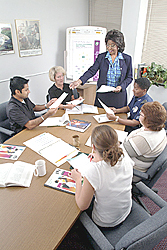How O-AIM Is Applied
Why Use the O-AIM?

The Outcome-Asset Impact Model (O-AIM) (Brown & Reed, 1998, 1999; Reed & Brown, 2001) is a powerful framework for local groups to enhance their own capacity to achieve change. The challenge facing all asset builders is to translate their beliefs, knowledge, and commitment into systematic, systemic, and sustained action. The O-AIM is designed to help asset-builders with this often daunting task.
Our hope is to encourage leadership by people in any position in local human service organizations and communities. Under this model, leadership means facilitating conditions that energize and mobilize others to work toward individual understanding and positive behavioral, cultural, and social change.
The model is not limited to addressing only certain types of issues. Instead, the O-AIM framework is highly generalizable and can be applied to any set of circumstances. The application of the O-AIM is composed of a series of steps. Each step moves participants through an increasingly elaborate journey of change, from initial orientation to full implementation and evaluation.
Who are the Facilitators and Core Team Members?
Facilitators of the O-AIM are MSU Outreach Partnerships staff who provide team members with the O-AIM framework and help them move through the steps. Facilitators help team members develop a level of understanding related to asset-building, outcome-based design and evaluation, and their content areas.
Core team members are individuals who provide leadership for the change effort. They are also called “Asset-Builders.” They are interested representatives who actually “do the work” and apply the O-AIM to their context.
Things to Note
The steps of the O-AIM (listed below) are the steps for applying the model. However, the challenge facing those who attempt this work will be the effective adaptation of the material to local circumstances. Because of the need to adapt the O-AIM to local circumstances, this is not intended to be a do-it-yourself guide. No website can speak to the rich diversity that exists in communities. We expect each reader to apply their own expertise in adapting this model to their unique circumstance.
To use the O-AIM, the partners work through each step in order. Although the steps are roughly chronological, in actual practice some aspects may occur concurrently and some steps may be repeated as necessary in order to get to the next step. In our experience, the more steps completed in order, the more successful the change effort.
Steps of the O-AIM
Click on each of the following steps for a more detailed description. Or, the following has all the steps and their descriptions.
- Identify an issue or problem that requires change. Then, select and orient core team members who will work toward this change.
- Identify the multiple levels on which assets will be built. The levels will include two or more of the following: individual; family or group; block, organization or agency; neighborhood or service delivery system; or community.
- Identify the desired impact and the assets necessary to achieve it.
- Identify the specific assets that the effort addresses.
- Translate understanding into action plans, which include identifying outcomes and activities to get there. Create logic models.
- Create an evaluation plan based on the logic models.
- Develop and implement the work plan.
- Create opportunities for building assets.
- Conduct process evaluation.
- Modify actions and strategies as needed.
- Conduct outcome evaluation
to monitor and maintain improvements over time.
Postscript: Spread the results of the application to others. Although this is not an official step of the O-AIM, it is nevertheless an important aspect.
NEXT PAGE> Go to the next section to see examples of the O-AIM applied to specific situations


